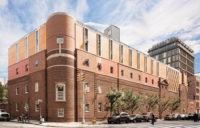Meinel Optical Sciences Expansion
Rich'rd and Bauer designs an outstanding laboratory space for the Meinel optical sciences expansion at the University of Arizona in Tucson
Richärd + Bauer, a young Phoenix-based firm, has demonstrated numerous times in its 11-year history that it can still advance architectural quality in inexpensive institutional buildings. Its new Meinel Optical Sciences Expansion at the University of Arizona in Tucson makes an even more emphatic claim for architectural innovation, spatial complexity, and the arresting use of light and materials. On top of that, the 47,000-square-foot structure cost only $14 million to build.

The commission from the College of Optical Sciences came with certain incentives. The three principals, James Richärd, AIA; Kelly Bauer, an interior designer; and Stephen Kennedy, AIA, had studied at the university and wanted to leave a memorable mark on their alma mater. And since the college ranks as one of the top optical-science schools nationwide, it needed to “speak of its status in its field,” says May Carr, senior architect for the university’s office of Facilities Design and Construction.
In following this mandate, Richärd + Bauer sought to bring about the same conflation of institutional identity with architecture achieved by a canonic predecessor in laboratory design, Louis Kahn’s Salk Institute for Biological Studies in La Jolla, California, of 1965. The firm emulated Kahn’s containment and manipulation of light and clarification of function at the Salk, as it admired the integration of architecture with nature displayed in Tod Williams and Billie Tsien’s 1995 Neurosciences Institute nearby. The Tucson project was to be an addition to a 1960s building fronting University Boulevard, the main street of the university campus. Since the 6-story expansion would occupy a corner site, the northern (entrance) facade and the west elevation would be seen easily from afar. (The east side hooks into the existing building, and the south side is bordered by a parking lot.)
The program called for flexible laboratories, where 200 undergraduate and more than 200 graduate chemists, physicists, optical engineers, and biologists would collaborate on research in geometrical, physical, quantum, and mathematical optics. Most labs required low to almost nonexistent light levels with no vibrations, and the floors needed to align with those of the building on the east––a reason why Richärd and Bauer depressed the building 7 feet below grade. In addition, the college wanted to provide informal gathering spaces, conference rooms, offices, and a lecture hall, elements not in full supply in the adjacent building.
PeopleArchitect Partner/Principal in charge: Partner/Interiors/Project manager: Partner/Lead Project Architect/Construction administration: Steve Kennedy (registered architect) Project architect: Andy Timberg (unregistered) Architect of record Interior designer: Engineer(s): Mechanical Electrical Plumbing Civil Contractor Consultants IT: Lab: General Contractor: Photographer: Renderer(s): Andy Timberg CAD system, project management, or other software used:
|
ProductsStructural system: Exterior cladding Metal/glass curtainwall(see windows): Roofing Windows Glazing Glass: Curtain wall PPG Solex ext and Low E inner Manf. by: Glass at the lobby was provided by : Skylights: Southwest Aluminum Systems Doors Metal doors: Wood doors: Interior finishes Hinges: Closers: Rixson Von Duprin Pulls: Security devices: Pulls: Interior finishes Suspension grid: Foamed Aluminum (lecture hall) Cabinetwork and custom woodwork: Paneling: Foamed Aluminum (lecture hall) Plastic laminate: Special surfacing: Floor and wall tile (cite where used): Resilient flooring: VCT Carpet: Durkan Commercial Office furniture: Reception furniture: ICF Peter Pepper Fixed seating: Chairs: Brayton International ICF Tables: Upholstery: Carnegie Fabrics Lighting Track, striplights: Downlights: Task lighting: Exterior: Controls: Lutron Conveyance Plumbing Faucets: Additional building components or special equipment: |




